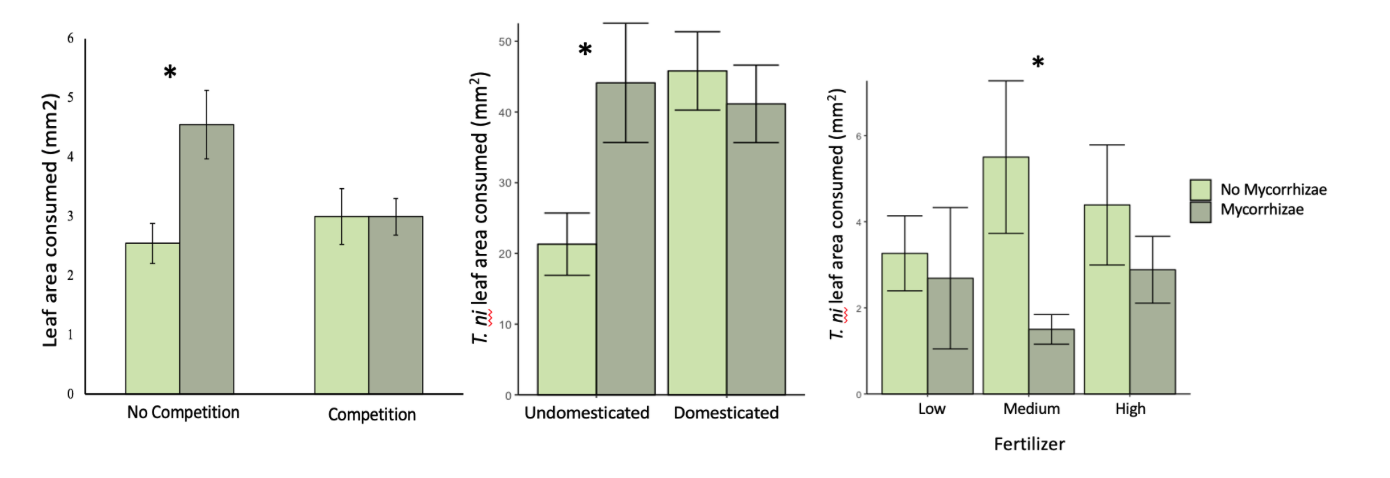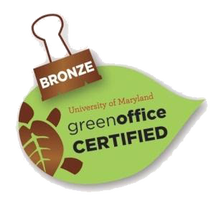|
written by: Angela Saenz and Eva Perry On February 12th (2021), Dr. Zoe Getman-Pickering, who obtained her Ph.D. from Cornell University in 2020 and is currently a postdoctoral scientist working at George Washington University with John Lill, spoke in the Entomology Colloquium series about her research related to the tri-trophic interactions between plants, herbivorous insects, and arbuscular mycorrhizal fungi (referred to as mycorrhizal fungi, or mycorrhizae, hereafter). She described her work on the relationship between plants and mycorrhizal fungi, and the biotic and abiotic factors influencing this relationship. In this talk, Dr. Getman-Pickering explained the role that mycorrhizae have in growth and resistance in some crops. Arbuscular mycorrhizae are soil-borne fungi that colonize plant roots and improve the host capacity for nutritional intake by increasing the root surface by more than 100-fold (Gao et al. 2020). Mycorrhizae have an essential role in the ecosystem as they mediate a series of complex communication events, improving the photosynthetic rate by increasing the “sink effect” and movement of photoassimilates from aerial parts to the roots, but also by improving the quality of the soil as they influence the soi structure and texture (Begum et al., 2019). Dr. Getman-Pickering discussed the variability in the quality of mycorrhizal associations for host plants, notably how those associations can range along a scale from a mutualistic relationship (which is beneficial to both the fungus and the host plant) to a parasitic relationship (in which the host plant suffers due to this association). To understand how multi-trophic factors might influence where the fungus-host plant relationship falls on a mutualism-parasitism scale, she designed and conducted three greenhouse experiments examining fertilization, plant domestication, and plant competition. To ascertain fertilizer’s effect on the fungus-host plant relationship, Dr. Getman-Pickering used field-collected mycorrhizal fungi on tomato plants in three fertilizer levels (low, medium, and high) and cabbage looper moth (Trichoplusia ni; Figure 1) larvae on a greenhouse study. She found with fungi the plants (1) grew better in low fertilizer but worse in high fertilizer and (2) decreased the nutritional value of their leaves while increasing certain chemical defenses against herbivores, and (3) experienced a significant reduction in leaf tissue consumed for plants both in medium and low-level fertilizer (Figure 2). These results suggest that the fungus-host plant relationship is mutualistic in nutrient-limited environments. Her second greenhouse study, this one examining plant domestication, used six commercial crops and six of their closest undomesticated relatives, a commercially available mycorrhizal fungus species (Rhizophagus intraradices), and three insect species. Two herbivores, the cabbage looper moth (T. ni), the tobacco hornworm (Manduca sexta), and one omnivore, the spined soldier bug (Podisus maculiventris), fed on these plants[1] (Figure 1). Dr. Getman-Pickering found that growth was suppressed in mycorrhizae-inoculated undomesticated plants, but plant physical and chemical defenses against herbivory were promoted. The nutritional quality of leaf tissue for herbivores was reduced the most in mycorrhizae-inoculated undomesticated plants. These qualities affected the specialist M. sexta much less than the two generalists; this suggests that mycorrhizae may play a role in shaping community structure aboveground. Dr. Getman-Pickering’s third greenhouse study used tomato plants grown either singly or in pairs, applied R. intraradices to half of them, and tested herbivory of T. ni caterpillars, to ascertain how plant competition affects the fungal-host plant relationship. She found that growth was not affected by mycorrhizal association for either single or paired plants. However, plant defenses and herbivory were suppressed for singly grown plants with mycorrhizae (Figure 2). Dr. Getman-Pickering noted that the plants were grown in low fertilizer conditions to force competition, which may have resulted in the mycorrhizae competing for nutrients with the plants. She also pointed out that because the second and third greenhouse experiments used a single commercially available mycorrhizal species, the results may differ if field-collected mycorrhizae were used instead. Existing literature supports that mycorrhizal diversity is more beneficial to plants than singular mycorrhizal species (van der Heijden et al. 1998); it is possible that greater mycorrhizal diversity allows for plants to select for the most beneficial relationship, or that competition between mycorrhizal species increases the nutrients given to the plant. Before closing, Dr. Getman-Pickering briefly described a side project she developed as a graduate student that resulted in a mobile app called LeafByte, which has already been downloaded from the AppStore more than 5000 times. This application measures leaf area and herbivory by just using a white sheet, four dots, and a camera, working as a quick and accurate research tool (Getman‐Pickering et al., 2020). She is currently working on a research project with John Lill and Martha Weiss to study the effects of the Brood X periodical cicadas (due to emerge in Spring 2021) on oak forest food webs and to observe if the satiation behavior of birds will have an impact on caterpillar population, and if so, how herbivory and parasitoid wasp population will be affected. She is also working on producing educational resources to teach elementary students about cicadas, for more information visit their website: https://friendtocicadas.org/.
References: Begum, N., Qin, C., Ahanger, M. A., Raza, S., Khan, M. I., Ashraf, M., Ahmed, N., & Zhang, L. (2019). Role of arbuscular mycorrhizal fungi in plant growth regulation: implications in abiotic stress tolerance. Frontiers in plant science, 10, 1068. https://doi.org/10.3389/fpls.2019.01068 Gao, X., Guo, H., Zhang, Q., Guo, H., Zhang, L., Zhang, C., Gou, Z., Liu, Y., Wei, J., Chen, A., Chu, Z., & Zeng, F. (2020). Arbuscular mycorrhizal fungi (AMF) enhanced the growth, yield, fiber quality and phosphorus regulation in upland cotton (Gossypium hirsutum L.). Scientific reports, 10(1), 1-12. https://doi.org/10.1038/s41598-020-59180-3 Getman‐Pickering, Z. L., Campbell, A., Aflitto, N., Grele, A., Davis, J. K., & Ugine, T. A. (2020). LeafByte: A mobile application that measures leaf area and herbivory quickly and accurately. Methods in Ecology and Evolution, 11(2), 215-221. https://doi.org/10.1111/2041-210X.13340 van der Heijden, M., Klironomos, J., Ursic, M. et al. (1998). Mycorrhizal fungal diversity determines plant biodiversity, ecosystem variability and productivity. Nature 396, 69–72. https://doi.org/10.1038/23932 Angela Saenz is a Master’s student in the Gruner lab, interested in the community interactions of natural enemies in forestry areas. Eva Perry is a PhD student in the Burghardt lab, interested in how phytochemical diversity affects insects and their predators in urban ecosystems. Comments are closed.
|
Categories
All
Archives
June 2024
|
Department of Entomology
University of Maryland
4112 Plant Sciences Building
College Park, MD 20742-4454
USA
Telephone: 301.405.3911
Fax: 301.314.9290
University of Maryland
4112 Plant Sciences Building
College Park, MD 20742-4454
USA
Telephone: 301.405.3911
Fax: 301.314.9290



 RSS Feed
RSS Feed




